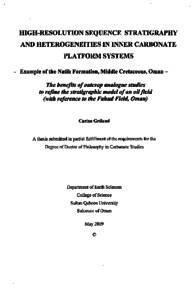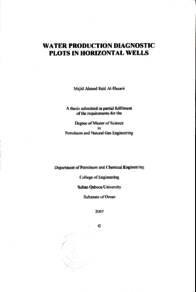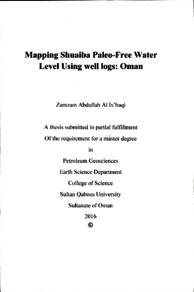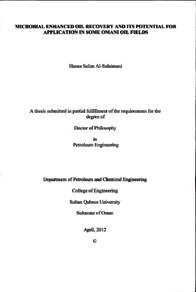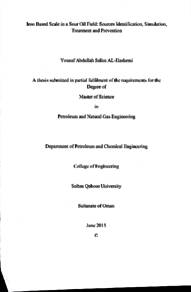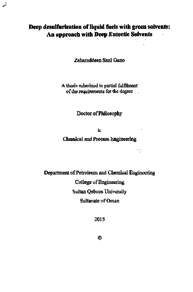Document
Application of extended elastic impedance for lithology and fluid discrimination in gharif, miqrat and amin formations
Publisher
Sultan Qaboos University
Gregorian
2018
Language
English
English abstract
Extended Elastic Impedance (EEI) method was first introduced by Whitecombe in 2007 as a lithology and fluid indicator. The EEI method rotates the conventional Acoustic Impedance (AI) with angles called Chi angle that ranges from -90 to +90. Each Chiangle can be correlated to different petrophysical parameters like Porosity, Vsh, Saturation and Gamma ray and also to elastic parameters such as Velocity ratio (Vp/Vs), Density, Acoustic impedance, Shear Modulus or Bulk modulus...etc. The EEI can be an alternative method to AVO inversion with much lower cost and time for fluid and lithology discrimination. The Objective of this study is to examine the EEI on a data from Oman for lithology and fluid discrimination; then to compare the results with the AVO inversion results that was run earlier to see the similarities and differences between the two approaches
The EEI method is applied to more than 30 wells from four different fields of the northem portion of Oman addressing two main issues:
• Lithology discrimination between sand and shale in the Gharif Formation. Gharif
sand and shale facies are known to have almost the same Acoustic Impedance (AI). which makes it difficult to discriminate using conventional deterministic
inversion. • Fluid discrimination in Amin and Miqrat Formations which are known to be very tight reservoirs.
Rock physics and EEI analysis at the well data are conducted to find the optimum parameters to discriminate between sand and shale facies at the level of Gharif Formation and between gas and brine saturated-sands in the level of Amin and Miqrat Formations. Neutron density crossover method turned out to be the optimum parameters for lithology discrimination within the Gharif Formation. Chi Angles of 87 and 16 were found to be the optimum angles that matches with Neutron and Density logs respectively. The two angles were compared to the real Neutron and Density logs and were found to be similar in both well and cross plots scale. The EEI operates in the domain of the intercept vs. gradient mainly by rotating the domain's coordinates by angle of Chi. So, rotating the extracted intercept and gradient by angles 87 and 16 enabled the study to have two relative volumes
of neutron and density. The interpretations of these two volumes needed thorough analysis to conclude whether the Gharif Formation channels could be seen by this approach or it is beyond the seismic resolution.
Velocity ratio (Vp/Vs) was found to be the most appropriate parameter for fluid discrimination in the tight rocks of Amin and Miqrat Formations. Chi angle of 30 was found to be the optimum angle that matches the Vp/Vs log. The extracted Intercept and Gradient were then rotated by the angle 30 and created a relative volume of Vp/Vs at Amin Formation level that was used to locate the brine and gas zones. The comparison between the EEI and AVO inversion results showed a high potential of similarities.
The study opened the doors for further studies for three possible business impacts opportunities at Amin and Shuaiba levels in the Kauther Survey. Low Vp/Vs anomalies - that have proven to be an indication of gas sands- were spotted at a three way dip closure associated with a fault plane trap system at Amin Formation that was never drilled before. The same anomalies were also noticed at a long features in the Amin Formation and in four way dip closure at Shuaiba Formation level. These low Vp/Vs anomalies were following the surface structural maps which rises the confidence of these prospects.
Arabic abstract
لقد تم استخدام طريقة ال Extended Elastic Impedance وتختصر بل EEI كطريقة للتمييز بين مختلف أنواع الصخور والسوائل الموجودة في داخل مسامات الصخور في باطن الأرض، لقد تم استخدامها لأول مرة في عام 2007 من قبل العالم وايت کومب (2002 Whitecombe). تكمن فكرة الEEI بعملية إدارة ال Acoustic Impedance حول محور في نطاق زوايا من 90 الى +90. كل زاوية من هذه الزوايا يسمى بزاوية كي (Chi Angle). لقد اثبتت الدراسات والخبرات السابقة أن بعض زوايا کي (Chi angles تتشابه بشكل كبير مع مختلف السجلات السلكية (Wireline les)، على سبيل المثال سجلات اشعاع جاما (Gamira Ray Log سجلات السامية لدى الصخور (potensity Log) سجلات الإشباع السائلي (Saturation Log) وغيرها الكثير. لقد تم استخدام معلومات أكثر من ثلاثون بترا نفطيا من أربعة حقول نفطية مختلفة من شمال سلطنة عمان. تكمن أهداف هذه الدراسة في التمييز بين الصخور السالمية و الصماء في صخور غريف الهدف الثاني هو تحديد أماكن تواجد الغاز والماء في صخور مقراط وأمين أهمية الدراسة تكمن في تقليل مخاطر الحذر وتحديد أماكن مكامن الغاز وكمياتها بشكل أدق،
لقد أثبت خلال هذه الدراسة أن طريقة ال Neutron Density cross Over method هي الطريقة المثلى التمييز بين صخور عريف التحليلات أيضا أثبتت أن الموازي لهذه الطريقة هي زوايا کي 16 و18، تم المقارنة بين الطريقتين ووجد أن أوجه التشابه كبدي بين الطريقتين في تحديد مواقع الصخور المختلفة بعد ذلك تم تطبيق هذه الطريقة على مكعب الطريقة السيزمية لكي يتم تحديد أمتداد الأنواع المختلفة من الصخور ولكن الخلاصة ما زالت تحتاج دراسات مطولة أخری في الجانب المقابل، لقد تم اعتبار خاصية الى ( Vp / Vs ) ي الخاصية المثلى للتفريق بين الماء والغاز في داخل صخور أمين. ووجدت أن زاوية كي (30 في الزاوية المتلى المشابهة لخاصية ال ( Vp/ Vs ). تطبيق هذه الزاوية على مكعب الطريقة السيزمية(Seismic Cube) تمكننا من تحديد مواقع الغاز والماء في صخور أمين النتائج كانت مشابهة جدا النتائج (AVO inversion و هي دراسة أجريت في وقت سابق. تعتبر طريقة ال EETطريقة سريعة ورخيصة جدا مقارنة بال (AVO inversion) لذلك فالدراسة تنصح باستخدام طريقة ال EET كطريقة مبدئية للحصول على صورة سريعة الباطن قبل استخدام الAVO inversion لقد فتحت هذه الدراسة الأبواب على مصراعيها لثلاثة مكامن محتملة للغاز والنفط في صخور أمين وشعيبة. لذلك فالدراسة تنصح باستمرار الدراسة في هذه المكامن المحتملة وتحديد الجدوى الاقتصادية منها.
لقد أثبت خلال هذه الدراسة أن طريقة ال Neutron Density cross Over method هي الطريقة المثلى التمييز بين صخور عريف التحليلات أيضا أثبتت أن الموازي لهذه الطريقة هي زوايا کي 16 و18، تم المقارنة بين الطريقتين ووجد أن أوجه التشابه كبدي بين الطريقتين في تحديد مواقع الصخور المختلفة بعد ذلك تم تطبيق هذه الطريقة على مكعب الطريقة السيزمية لكي يتم تحديد أمتداد الأنواع المختلفة من الصخور ولكن الخلاصة ما زالت تحتاج دراسات مطولة أخری في الجانب المقابل، لقد تم اعتبار خاصية الى ( Vp / Vs ) ي الخاصية المثلى للتفريق بين الماء والغاز في داخل صخور أمين. ووجدت أن زاوية كي (30 في الزاوية المتلى المشابهة لخاصية ال ( Vp/ Vs ). تطبيق هذه الزاوية على مكعب الطريقة السيزمية(Seismic Cube) تمكننا من تحديد مواقع الغاز والماء في صخور أمين النتائج كانت مشابهة جدا النتائج (AVO inversion و هي دراسة أجريت في وقت سابق. تعتبر طريقة ال EETطريقة سريعة ورخيصة جدا مقارنة بال (AVO inversion) لذلك فالدراسة تنصح باستخدام طريقة ال EET كطريقة مبدئية للحصول على صورة سريعة الباطن قبل استخدام الAVO inversion لقد فتحت هذه الدراسة الأبواب على مصراعيها لثلاثة مكامن محتملة للغاز والنفط في صخور أمين وشعيبة. لذلك فالدراسة تنصح باستمرار الدراسة في هذه المكامن المحتملة وتحديد الجدوى الاقتصادية منها.
Member of
Resource URL
Same Subject
